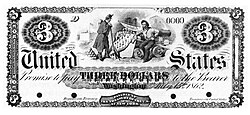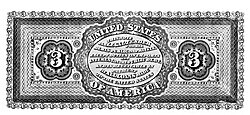

This article has multiple issues. Please help improve it or discuss these issues on the talk page. (Learn how and when to remove these template messages)
|
The United States has several coins and banknotes which were proposed at one time but never adopted.
A three dollar bill was proposed two times during the 1860s. A design was engraved for a potential $3 United States Note, and a 1865 law called for a $3 National Bank Note, but neither proposal came to fruition.[citation needed]
| Denomination | Obverse | Reverse | Notes |
|---|---|---|---|
| $3 note | 
|

|
Not to be confused with fake or privately issued obsolete notes or the three-dollar Continental currency banknotes issued during the American Revolution |
There have been several United States coins which were proposed but never adopted. Most of the coins listed below, although never adopted, were produced in limited numbers as patterns.
| Denomination | Obverse | Reverse | Weight | Diameter | Material | Edge | Minted | Notes |
|---|---|---|---|---|---|---|---|---|
| Silver center cent 1¢ |

|

|
4.48 g | 24.00 mm | Cu (ring) Ag (plug) |
reeded | 1792 | The first and only US bi-metallic coin until the 2000 Library of Congress ten dollar coin. |
| Ring cent 1¢ |

|

|
various weights | 90% Cu
10% Ag[a] |
various | 1850–1851, 1853[b], 1884–1885 | 196 ring cents (originals and restrikes) are known to exist.[1] Examples exist with or without a hole. | |
| Aluminum cent 1¢ |

|

|
0.937 g | 19.05 mm | 96% Al 4% trace metals |
plain | 1973–1975 | 1,579,324 coins dated 1974 were produced, but were not put in circulation and nearly all were later destroyed.[2] |
| Two-cent billon 2¢ |

|

|
3.84 g | ~13.00 mm | 90% Cu 10% Ag |
plain | 1836 | [3] |
| Two and a half cent piece 2.5¢ |
unknown | unknown | unknown | unknown | never minted | Proposed in 1916 by US mint director Robert W. Woolley.[4] Civil War tokens of this denomination exist. | ||
| Three-cent bronze 3¢ |

|

|
10.89 g | 28.57 mm | 95% Cu 5% Zn |
plain | 1863 | |
| Ring nickel 5¢ |

|

|
plain | 1884–1885 | [5][6] | |||
| Gold ring half dollar 50¢ |

|

|
1852 | [7] | ||||
| Gold ring dollar $1 |

|

|
1849, 1852 | [8][9] | ||||
| Two dollar piece $2 |
unknown | unknown | unknown | unknown | never minted | Proposed but not minted.[10] Some privately struck renditions exist.[11] | ||
| Stella $4 |

|

|
7.00 g | 22 mm | 6.00g Au 0.30g Ag 0.70g Cu |
reeded | 1879–1880 | [12] |
| Half-union $50 |

|

|
83.58 g | 50.80 mm | 90% Au 10% Cu[c] |
reeded | 1877 | Commemorative coins of this denomination were issued in 1915.[14]
Several bullion coins are produced in this denomination. |
| Union $100 |

|

|
unknown | unknown | 90% Au 10% Cu |
unknown | never minted | Canceled before any patterns could be minted (fantasy coin shown).
Some commemorative and bullion coins are minted in this denomination. |
|
| |||
|---|---|---|---|
| Topics |
| ||
| Coins |
| ||
| Currency |
| ||
This article about a unit of currency is a stub. You can help Wikipedia by expanding it. |